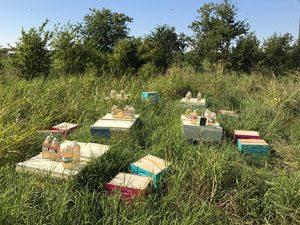
BEES DON’T NEED FENCES!
And that’s just one advantage of using beekeeping for AG valuation instead of raising cattle on your 5-20 acre parcel. Or maybe you want cute little goats, like I did, until my husband told me to “google: GOAT ON CAR”! Not my car, no thanks! Now we keep bees and we can help you get started with an amazing hobby or part-time business!

STATE LAW CHANGED IN 2012:
Texas Tax Code: Chapter 23, Subchapter D. Appraisal of Agricultural Land Sec. 23.51 – (2) “Agricultural use” includes but is not limited to the following activities: ….”The term also includes the use of land to raise or keep bees for pollination or for the production of human food or other tangible products having a commercial value, provided that the land used is not less than 5 or more than 20 acres.”
5-20 ACRES OF LAND
Amount of land required and you must not live in a subdivision that has restrictions against bees or AG usage. You may be able to buy or lease bee colonies to keep on your land and lower your property taxes. AG use is required for 5 of the last 7 years in order to begin receiving the lower valuation. That means you utilize the land in beekeeping for 5 years in a row and the 6th year your taxes will go down if you meet all the requirements for your county. Each county appraisal district sets their own rules for eligibility, so be sure to talk with your county appraisal district and to stay current with rules year to year.

WHAT ABOUT MY HOMESTEAD EXEMPTION?
If you live on the land and have your house and homestead there, you will need to set aside approximately 1 acre of the land for your house/homestead. The remainder of land (minimum of 5 acres) will be to start the new AG valuation. Keep in mind as you are working AG, you won’t qualify for the homestead exemption on those extra acres, so your taxes will be higher until you achieve AG. No ‘double-dipping’ with your exemptions. Either take a homestead exemption or be working on AG, not both at once on the same acreage.
HOW MUCH WILL I SAVE?
The Ag valuation savings number is different for everyone depending on what county you are in and how many acres you have and your land values, of course. BUT, if you have HIGH property taxes now, you will likely be VERY pleased with the new valuation. Counties we have worked with seem to be using “orchard values” on the property once it goes into AG, which means thousands of dollars in tax savings for you. For instance, I have seen properties in Travis County go from a regular tax value of $40,000-$70,000 per acre down to an AG value of $2,000 per acre!!! Would you rather pay property tax on $40,000 or on $2,000? EXACTLY! 🙂

I DON’T KNOW HOW TO KEEP BEES!
There are several options to help with this concern. You can read some books, take some classes, or join a beekeeping club. Hire a beekeeper to manage your bee colonies for you and advise you on what to buy. Or lease bees from a beekeeper and let that beekeeper manage the bees. It all depends on the location of your land, availability of bees, and the amount of time and money you have to spend. The owners at Texas Honey Bee Farm are here to help you! We are the one-stop-shop to get you off to the best start. We offer classes and consulting, and we sell bees and equipment.

HOW MANY HIVES ARE REQUIRED?
Each county sets its own minimum standards, but typically you will need 6 hives for the first 5 acres plus 1 more hive for every 1.5 – 2 additional acres. For example, Travis County and Williamson County both require adding another hive for each additional 2 acres, whereas Hays County requires another hive for every additional 1.5 acres. Download pdf below:
WHAT IS A HIVE? HOW MANY BOXES IS THAT?
A bee colony is the family of bees living together in one set of boxes. The colony includes the Queen, Drones, and Worker bees. This could be 10,000 – 60,000 total bees. Equipment or hive boxes are the boxes that you will provide to each colony for living, colony growth, and honey storage. Even though a bee colony starts out with one box, it may grow to need many. Therefore a hive is one colony of bees AND the box or boxes they live in and store food in. In a typical Langstroth hive, the boxes are stacked one upon the other, regardless of how high they get stacked. It is still just one colony or one hive of bees.

WHERE TO BUY BEES & EQUIPMENT
At Texas Honey Bee Farm an we will help assess your needs, plan your site management, go over your county’s minimum requirements and assist you with the selection of bees and equipment. We provide estimates, invoices for tax documentation, advice, and support at the level you need along the way. Our experts offer management service contracts by the visit or by the year. Keep in mind that orders for spring bee colonies begin in the fall of the previous year, so order early. AG valuation applications are due by April 30th and bees are not available year round.



